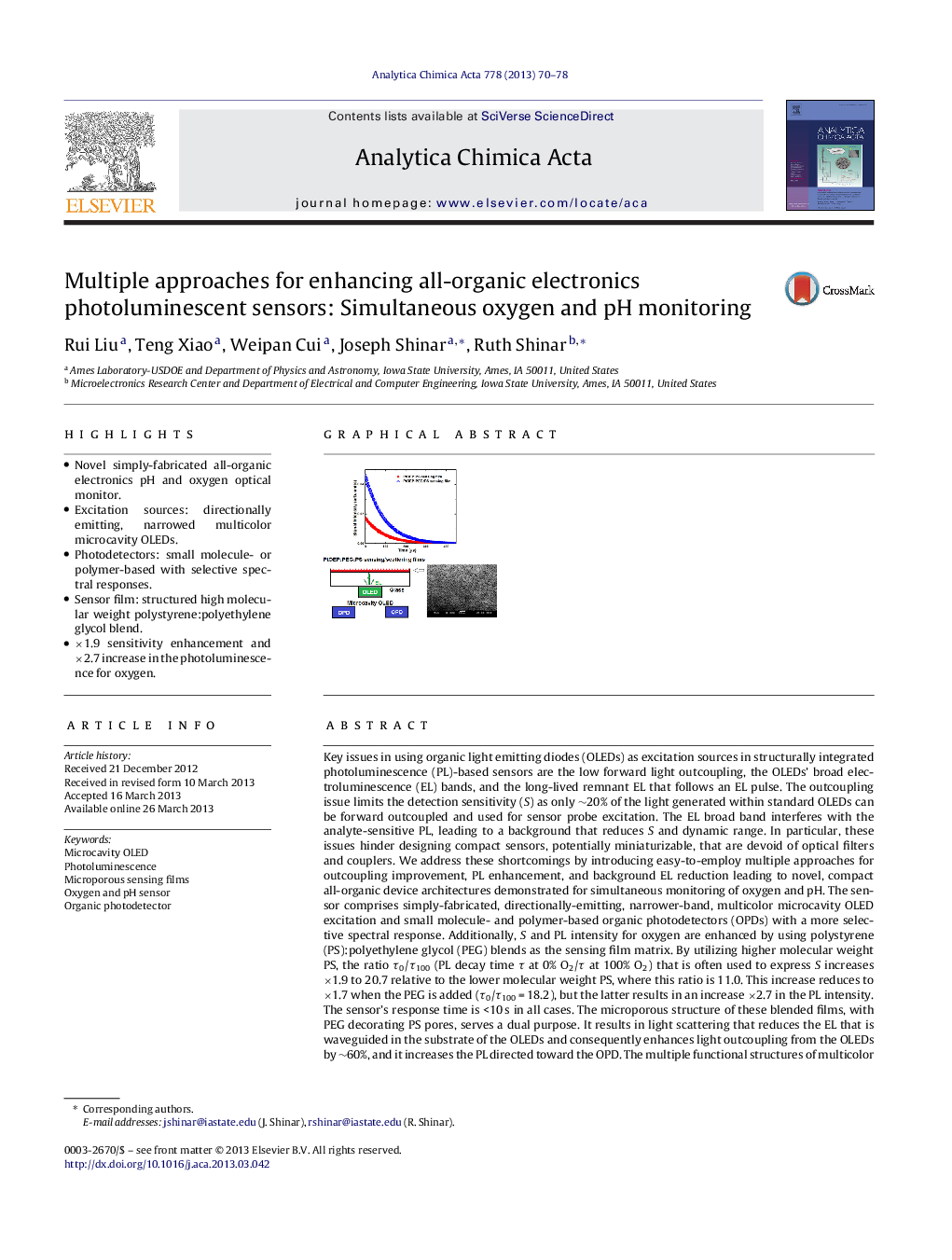| کد مقاله | کد نشریه | سال انتشار | مقاله انگلیسی | نسخه تمام متن |
|---|---|---|---|---|
| 1165792 | 1491054 | 2013 | 9 صفحه PDF | دانلود رایگان |

• Novel simply-fabricated all-organic electronics pH and oxygen optical monitor.
• Excitation sources: directionally emitting, narrowed multicolor microcavity OLEDs.
• Photodetectors: small molecule- or polymer-based with selective spectral responses.
• Sensor film: structured high molecular weight polystyrene:polyethylene glycol blend.
• ×1.9 sensitivity enhancement and ×2.7 increase in the photoluminescence for oxygen.
Key issues in using organic light emitting diodes (OLEDs) as excitation sources in structurally integrated photoluminescence (PL)-based sensors are the low forward light outcoupling, the OLEDs’ broad electroluminescence (EL) bands, and the long-lived remnant EL that follows an EL pulse. The outcoupling issue limits the detection sensitivity (S) as only ~20% of the light generated within standard OLEDs can be forward outcoupled and used for sensor probe excitation. The EL broad band interferes with the analyte-sensitive PL, leading to a background that reduces S and dynamic range. In particular, these issues hinder designing compact sensors, potentially miniaturizable, that are devoid of optical filters and couplers. We address these shortcomings by introducing easy-to-employ multiple approaches for outcoupling improvement, PL enhancement, and background EL reduction leading to novel, compact all-organic device architectures demonstrated for simultaneous monitoring of oxygen and pH. The sensor comprises simply-fabricated, directionally-emitting, narrower-band, multicolor microcavity OLED excitation and small molecule- and polymer-based organic photodetectors (OPDs) with a more selective spectral response. Additionally, S and PL intensity for oxygen are enhanced by using polystyrene (PS):polyethylene glycol (PEG) blends as the sensing film matrix. By utilizing higher molecular weight PS, the ratio τ0/τ100 (PL decay time τ at 0% O2/τ at 100% O2) that is often used to express S increases ×1.9 to 20.7 relative to the lower molecular weight PS, where this ratio is 11.0. This increase reduces to ×1.7 when the PEG is added (τ0/τ100 = 18.2), but the latter results in an increase ×2.7 in the PL intensity. The sensor's response time is <10 s in all cases. The microporous structure of these blended films, with PEG decorating PS pores, serves a dual purpose. It results in light scattering that reduces the EL that is waveguided in the substrate of the OLEDs and consequently enhances light outcoupling from the OLEDs by ~60%, and it increases the PL directed toward the OPD. The multiple functional structures of multicolor microcavity OLED pixels/microporous scattering films/OPDs enable generation of enhanced individually addressable sensor arrays, devoid of interfering issues, for O2 and pH as well as for other analytes and biochemical parameters.
Figure optionsDownload as PowerPoint slide
Journal: Analytica Chimica Acta - Volume 778, 17 May 2013, Pages 70–78